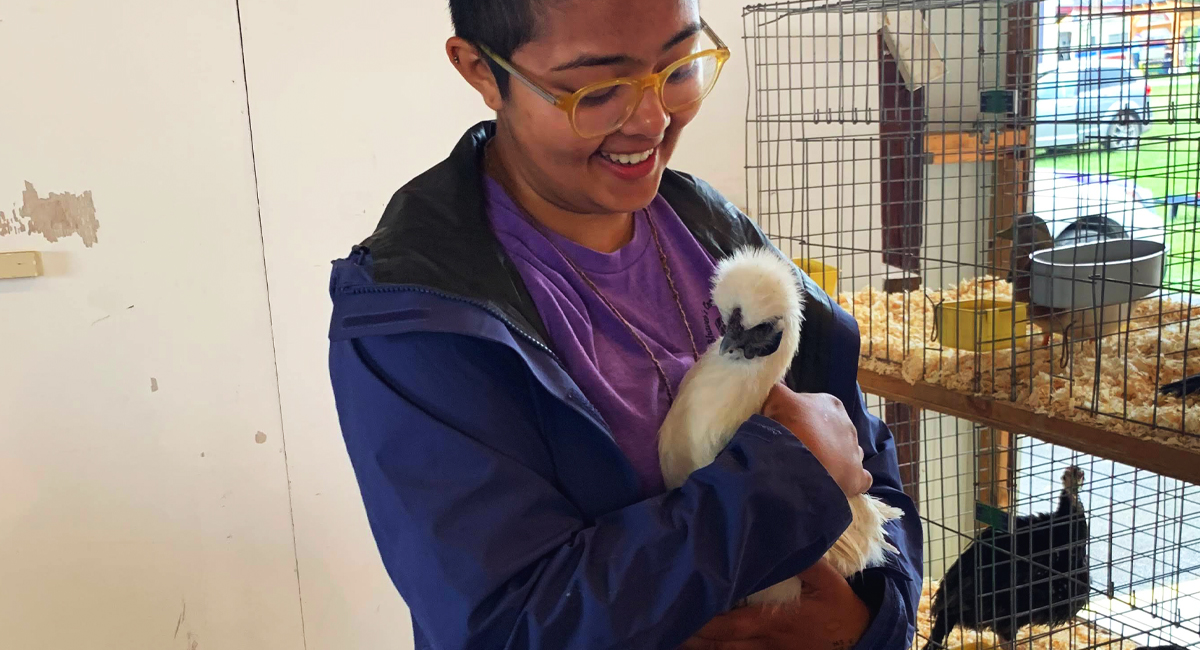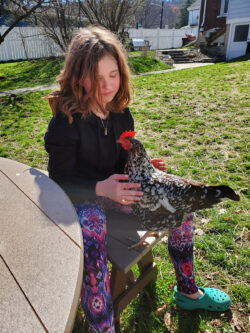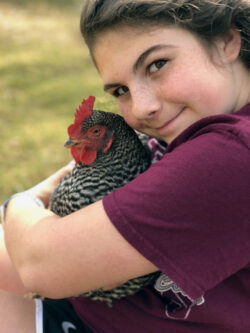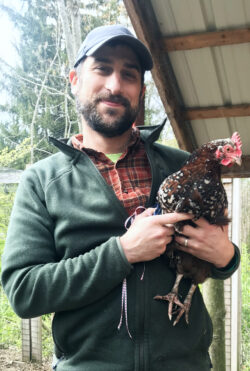
Suddenly, the loud, packed bustle and strikingly bright colors of the New Delhi market started to fade like a vignette for the beautiful animal now in my focus. Tomato red wattles and a comb contrasted starkly with soft, white feathers. As I marveled at the pillow-like tufts, dry, scaly feet emerged from beneath them. I’d never been close enough to a chicken before to notice all of these textures. I watched closely as the chicken moved in its tiny cage at the front of the market stall, with an ankle cuff further limiting its movement. For a brief moment, I dreamed of being able to feel its feathers and care for this chicken over the course of a day, a year, maybe even its whole life.
Ever since this first close encounter with a chicken at the age of twelve, I have been intrigued by these strange, ancient creatures. Growing up in the suburban sprawl of Columbus, Ohio, I rarely got closer to these animals than having eggs for breakfast or chicken for dinner. I had never even heard of people keeping backyard chickens until I was a junior in high school.
Last August, I held my very first chicken while on a break from working at Shaver Creek’s tent at Penn State’s Ag Progress Days. The white Silkie chicken was so calm and fluffy, I was at a loss for words and instead felt tears filling my eyes. I knew right then that I would do everything I could to raise my own chickens someday.
Fast forward to a few weeks ago, when my landlord learned of my interest in chickens and asked me to help research chicken care and costs. I am thrilled to have this opportunity to learn about best practices for raising and keeping backyard chickens. As part of educating myself on chicken care, I interviewed and visited three backyard chicken coop setups here in central Pennsylvania. Whether you have always been intrigued by chickens or you simply want to learn more about backyard chicken farming, read on for eight tips I learned about keeping chickens!

Check your local township regulations to learn about how many chickens you are permitted to keep and if there are any other restrictions on chicken set-up. Josh Potter explained, “It depends on where you live [if you’re allowed to keep a rooster]. In Maine, we called the animal control officer and we said, we want to know if we’re allowed to have chickens. He said, it depends… on who your neighbor is, and on whether I’m going to be getting calls. If your neighbor is okay with it, I’m okay with it.” (While many townships have more strict guidelines, I appreciated this unique approach.)
There are plenty of breeds to choose from, and many factors can contribute to a farmer’s choice. Chris Ortiz’s family chose Barred Rocks, Gold-Laced Wyandottes, and Buff Orpingtons based on their friendliness, cold-hardiness, and American background. The Potters also have these breeds with the addition of a Speckled Sussex. The Muths have Speckled Sussex hens as well as Easter Eggers (which is not exactly a breed, but a variety), which they chose based on their egg productivity and friendly, even demeanor.
While people may have other reasons for getting backyard chickens, fresh eggs certainly make a delicious bonus! Chris Ortiz explained, “While we didn’t necessarily get into [chicken farming] thinking, ‘Oh, we want to stop buying factory eggs or spending all our money on store-bought eggs,’ … it was more of a project [that meant] we could have eggs.” Josh Potter gleefully reported, “The color of the yolk is just so much richer yellow than a store-bought egg… Delicious!”
Eggs can vary in color depending on chicken variety, the season, and if the chickens are molting. The Muths shared with me that their Easter Eggers produce beautiful olive-colored eggs. Between all four of their chickens, they get four eggs per day in the summer and two or three per day in the winter, and chickens will generally not lay eggs at all when they are molting.

Many folks enjoy keeping chickens as pets because of their bright personalities and relatively simple care needs. Handling chicks while they are young makes them more docile as adults. “If you want them to be nice when they’re older, you should handle them when they’re younger,” Chris Ortiz’s daughter Indy explained. Through 4H, Indy won first place for showing her chicken. The Muths shared that they enjoy the curiosity and special quirks of their birds, such as one hen dragging her beak along the wire mesh of the enclosed run as if to say she wants out to free-range.
Chickens are social creatures and have a strong pecking order, which makes introducing a new flock member challenging. Chris Ortiz explained, “You can see the pecking order really easily. There’s a few of them that are close to the bottom, and they’re the meanest. The top chicken is pretty calm and doesn’t peck at other birds all that much. But the ones that seem like they’re closer to being at the bottom, they are vicious to… the young [new chicks].” Chris advised new chicken farmers to “get the amount of chickens you want upfront. Don’t try to add to it later, when it’s a lot harder.”

Keep your pets away from your chickens, and research local predators. Sarah Potter shared with me that a hawk left a gory mess of one of their hens, so now the Potters have netting over their outdoor chicken yard to block raptor access to their flock. Chris Ortiz lost a hen to his family’s dog and another to a hawk.
Plan extensively by doing your research on chicken care and setup before getting chickens. Norris Muth advised new chicken farmers to “plan ahead in terms of breed, coop, supplies, handling cold or bad weather, and who takes care of the chickens when you go out of town.” To get started, you can talk to some local chicken farmers like I did, ask to see their setups, and check out these resources recommended by the farmers I talked with: A Chicken in Every Yard by Hannah and Robert Litt, 4H Poultry, and The Encyclopedia of Country Living by Carla Emery.
I have greatly enjoyed journeying into the world of backyard chicken farming and look forward to raising and keeping my own someday. I will end with a quote from a chicken expert in her own right, Sylvie Potter the Speckled Sussex: “Bawk-bawk-bawk, bawk-bawk!”
